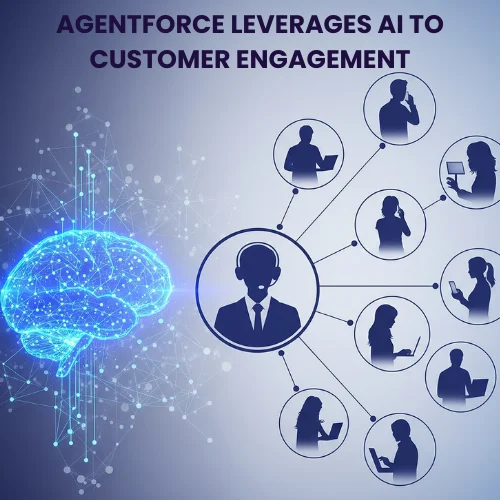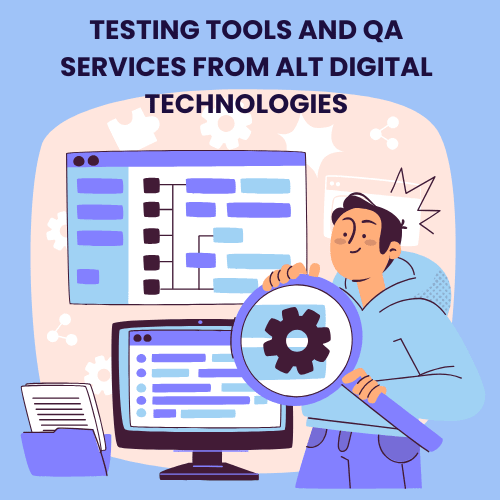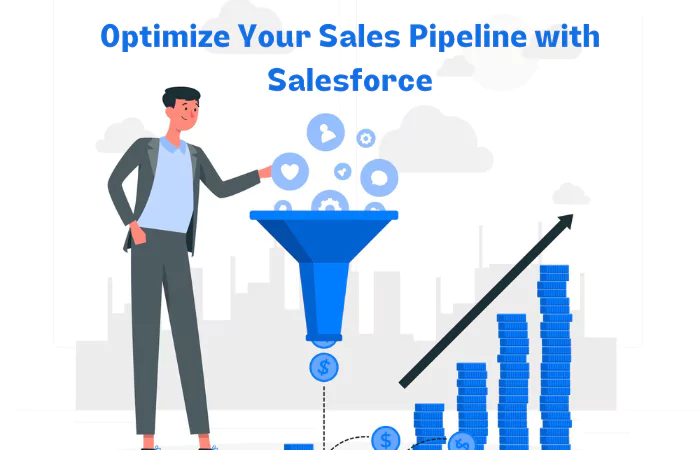Introduction
In sales, the journey from a lead to a deal is complex which involves multiple stages and requires careful management. This is where Salesforce, a globally known customer relationship management (CRM) platform, comes into play. Salesforce provides various tools designed to optimize your sales pipeline that transform leads into deals more efficiently and effectively. It allows businesses to streamline their sales process, enhance customer engagement, and ultimately, boost their bottom line. By using Salesforce, businesses can manage their sales pipeline and gain a competitive edge in the market.
What is a Sales Pipeline?

The sales pipeline is a visual snapshot of where potential customers are in the sales process. These potential customers are known as the ‘prospects’. The sales pipeline helps you identify the next steps and any potential obstacles or delays and ensures your deal continues to progress toward completion.
Don’t mix up a sales pipeline with a sales funnel. They both use similar data, but they serve different purposes. The sales pipeline tracks a potential customer’s progress in the buying process. This helps salespeople figure out the next steps to keep the deal going. For example, if a potential customer is stuck in the negotiation phase, a price adjustment might be needed to push them to the contract phase.
The sales pipeline includes stages like prospecting or lead generation, lead qualification, meeting, proposal, negotiation, and finally, closing the deal. It provides insights into the sales process, helps forecast revenue, and guides resource allocation.
Optimize Your Sales Pipeline with Salesforce
Salesforce offers various features that can help businesses optimize their sales pipeline:
Prospecting or Lead Generation

Prospecting or Lead Generation is the process of identifying and cultivating potential customers for a business’s products or services. It’s the first step in the sales process and involves a range of techniques to gather contact details of individuals or businesses that might be interested in what you’re offering. Salesforce helps in lead generation by integrating with various platforms. For example, Salesforce can be integrated with a company’s website to capture information from contact forms or newsletter sign-ups. This is done using Salesforce’s Web-to-Lead feature which can automatically create leads in the CRM from these sources. Similarly, integration with social media platforms allows businesses to capture leads from social interactions. Salesforce’s Social Studio can monitor social media for your brand or products, and automatically create leads from these interactions. This reduces manual data entry and ensures that no potential prospect is overlooked.
Lead Qualification and Scoring

Lead qualification and scoring are two related but distinct processes that help marketing and sales teams identify and prioritize the most valuable leads for their business.
Lead scoring is a method of assigning a numerical value to each lead based on various factors that indicate their likelihood to convert into customers. These factors can include demographic, firmographic, and behavioral data, such as lead’s industry, job title, website visits, email clicks, etc. Lead scoring helps to rank and segment leads based on their level of interest and readiness to buy.
Lead qualification is a process of determining whether a lead meets the criteria set by the company to be considered as a qualified lead. These criteria can include the lead’s fit with the target market, their level of need, their budget, their authority to make a decision, etc. Lead qualification helps to filter out leads that are not a good match for the company’s products or services, and focus on leads that have a high probability of becoming a customer.
Lead qualification and scoring work together to optimize the lead generation and sales process. By using lead qualification and scoring, marketing and sales teams can:
- Save time and resources by focusing on the most promising leads
- Increase conversion rates by delivering personalized and relevant messages to each lead
- Improve customer satisfaction and retention by matching the right products or services to the right customers
- Enhance collaboration and alignment between marketing and sales teams by sharing a common understanding of lead quality and value
Salesforce uses a feature called Lead Scoring and Grading to help businesses identify the most promising leads. This feature uses both explicit factors (like industry, job title, etc) and implicit factors (like online behavior, engagement with marketing content, etc.) to score and grade leads. This dual-layered approach ensures a more complete evaluation of leads. Salesforce’s Pardot, a B2B marketing automation tool, provides advanced lead scoring and grading capabilities. It allows businesses to customize the scoring model based on their unique business needs and ensure that the leads that are most likely to convert are prioritized.
Nurturing Leads

Nurturing leads is the process of building relationships with potential customers at every stage of the sales funnel until they purchase. It involves providing valuable offers and resources that persuade prospects to advance through the sales funnel. Nurturing leads is important because it helps you learn more about your target customers, build trust and loyalty, and increase conversions and sales.
Salesforce’s lead nurturing capabilities are powered by its Marketing Cloud, which offers features like Builder and Email Studio. Journey Builder allows businesses to design personalized customer journeys based on their interactions with the brand. This includes sending a series of educational emails to a new lead or offering a discount code to a lead who visited the pricing page but didn’t make a purchase. Email Studio, on the other hand, enables the creation and escalation of targeted email campaigns. These tools ensure that leads receive relevant and engaging content. So that they get hooked and the sales team can move them further down the sales pipeline.
But that’s not all. Salesforce also has other lead nurturing capabilities, such as:
- Marketing Automation: You can use tools like Pardot and Marketing Cloud Automation Studio to automate your lead-nurturing tasks, such as sending emails, updating records, scoring leads, and more. This saves you time and effort and ensures consistency and accuracy in your lead nurturing process.
- Hyper-Personalization: You can use tools like Marketing Cloud Personalization Builder and Einstein to create highly personalized experiences for your leads across different channels, such as web, mobile, social, and email. This helps you increase engagement and conversion rates by delivering the right message to the right person at the right time.
- Targeted Content Marketing: You can use tools like Marketing Cloud Content Builder and Social Studio to create and manage your content marketing strategy. You can create, edit, and publish various types of content, such as blogs, ebooks, infographics, videos, and more. You can also monitor and analyze the performance of your content across different platforms and optimize it accordingly.
- Multi-Channel Approach: You can use tools like Marketing Cloud, Journey Builder, and Salesforce CRM to connect with your leads across multiple channels, such as email, web, mobile, social, and phone. This helps you reach your leads where they are and provide a seamless and consistent experience throughout their journey.
- Lead Scoring: You can use tools like Pardot and Einstein Lead Scoring to assign scores to your leads based on their profile and behavior. This helps you identify the most qualified and interested leads and prioritize your follow-up actions.
- Follow-up Strategy: You can use tools like Salesforce CRM and Sales Cloud to track and manage your leads and opportunities. You can also use tools like Salesforce Inbox and High-Velocity Sales to streamline your email and phone communication with your leads. This helps you stay on top of your lead nurturing process and move your leads closer to the sale.
Converting Leads into Opportunities

Converting a lead into an opportunity means that the lead has shown a clear interest in the product or service and is ready for a sales approach. This conversion creates an Opportunity record, which includes detailed information about the prospect. This record is then used to track all future interactions with the lead and provides a complete view of the sales process. Salesforce’s Sales Cloud provides a range of tools to manage opportunities, including customizable sales stages, product and price books, and collaborative forecasting.
Some of the benefits of using Sales Cloud are:
- You can automate your sales processes and workflows to save time and reduce errors.
- You can use reports and dashboards to get real-time insights into your sales performance and pipeline.
- You can forecast your sales more accurately and align your sales goals with your business objectives.
- You can collaborate with your team and other stakeholders to share information and best practices.
- You can access your CRM data from anywhere, anytime, and on any device.
Sales Cloud is designed to help you sell smarter, faster, and more productively. If you want to learn more about Sales Cloud, you can check out these resources:
- Sales Cloud Basics: A guide to the core features and functionalities of Sales Cloud.
- Salesforce Automation Software by Sales Cloud: An overview of how Sales Cloud can help you grow your business and increase customer satisfaction.
- What is Salesforce Sales Cloud?: An article that explains the main modules and features of Sales Cloud and how they can benefit your sales operations.
- Boost Sales Productivity with Sales Cloud CRM: A trailhead module that introduces you to the Sales Cloud platform and how to use it to manage your sales cycle.
Closing the Deal

Closing the deal is the process of finalizing a sale with a customer, from sending a quote to receiving payment. It involves several steps that can be complex and time-consuming, such as configuring the offer, pricing the product or service, negotiating the contract, managing the order, and invoicing the customer.
Salesforce’s Quote-to-Cash (QTC) features support the final stages of the sales process. QTC includes the entire sales process from creating quotes to managing orders, contracts, and revenue. It automates many of the tasks involved in deal closure, reducing errors and speeding up the sales cycle.
Salesforce QTC consists of two main components: Salesforce CPQ and Salesforce Billing. Salesforce CPQ helps sales reps create and send quotes that are accurate, consistent, and customized to each customer’s needs. It also helps them apply for discounts, promotions, and approvals according to the business rules. Salesforce Billing helps sales reps generate and send invoices, collect payments, and manage revenue recognition. It also helps them handle subscriptions, renewals, and amendments.
By using Salesforce QTC, sales reps can benefit from:
- Reduced errors and delays in the quoting and invoicing process
- Increased efficiency and productivity in the sales cycle
- Improved customer satisfaction and loyalty
- Enhanced visibility and reporting on the sales performance and revenue
If you want to learn more about Salesforce QTC, you can visit this page for an overview, or this page for a detailed guide. You can also watch this video for a demonstration of how Salesforce QTC works.
Analyzing and Improving the Sales Process

Analyzing the sales process means measuring and evaluating how well the sales team is performing at each stage of the process. This can help identify the strengths and weaknesses of the sales strategy, as well as the opportunities and threats in the market. Analyzing the sales process can also help forecast sales revenue, identify sales trends, and track sales goals.
Improving the sales process means optimizing and enhancing the efficiency and effectiveness of the sales team. This can involve refining the sales methodology, improving the sales skills, streamlining the sales workflow, automating the sales tasks, and providing the sales tools. Improving the sales process can also help increase sales productivity, customer satisfaction, and competitive advantage.
Salesforce’s reporting and analytics capabilities are one of the key features that enable businesses to analyze and improve their sales process. Some of the benefits of using Salesforce’s reporting and analytics capabilities are:
- They provide real-time and accurate data on sales performance, such as the number of leads, opportunities, closed deals, revenue, etc.
- They allow users to create and customize reports and dashboards that show the key metrics and indicators of the sales process, such as the lead conversion rates, average deal size, sales cycle length, etc.
- They enable users to drill down into the data and explore the details and causes of the sales results, such as the source, stage, owner, product, etc. of the sales records.
- They facilitate collaboration and communication among the sales team and other stakeholders, by allowing users to share, comment, and act on the data and insights.
- They support data-driven decision-making and problem-solving, by providing users with actionable insights and recommendations based on the data and analytics.
Salesforce’s Einstein Analytics is an advanced analytics tool that takes reporting and analytics capabilities to the next level. It uses artificial intelligence (AI) to provide users with deeper and smarter insights and recommendations to further optimize the sales process. Some of the features and benefits of using Salesforce’s Einstein Analytics are:
- It uses machine learning and natural language processing to analyze billions of data combinations and surface the most relevant and impactful insights and recommendations for the sales process, such as the best leads to pursue, the best products to offer, the best time to contact, etc.
- It uses data visualization and storytelling to present insights and recommendations clearly and engagingly, using charts, graphs, tables, etc.
- It uses natural language generation to explain the insights and recommendations simply and understandably, using plain language and narratives.
- It uses predictive and prescriptive analytics to forecast future outcomes and suggest the best actions for the sales process, such as the expected revenue, the optimal price, the ideal discount, etc.
- It uses proactive alerts and notifications to inform users of the changes and opportunities in the sales process, such as the new leads, the hot deals, the at-risk accounts, etc.
- It uses embedded and integrated analytics to deliver insights and recommendations within the Salesforce environment, such as the CRM apps, the workflow tools, the business apps, etc.
Conclusion
To sum up, Salesforce has many tools to make your sales pipeline better. You can use Salesforce to find more leads, close more deals, and make your sales process faster and smoother. Salesforce can help you turn your sales pipeline into a powerful way to grow your business.



